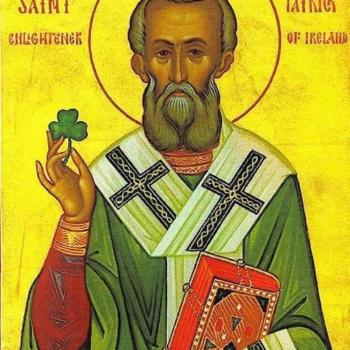This most recent travel experience, I was in Detroit Metropolitan-Wayne County Airport, which I've passed through rather rapidly on several occasions, and less so on others. This time, I had several hours in which my friends from the conference had already left and my own connecting flight had yet to board, so I sought out the chapel where I had seen the signs for it in previous trips. It was no longer marked as a "chapel," however, but instead as a "Religious Reflection Room." This should have indicated to me what the possible nature of the room itself would turn out to be. It was located in a non-public corridor of the airport terminal, between the floors usually accessible to travelers—a liminal place indeed.
As I followed the signs to get to it, an elevator was revealed to be the way to it, and next to the elevator, there was a prominent sign reading "Authorized Personnel Only." A very mixed message, to say the least, but given that I do have clergy status within my own religion, I was certainly authorized to go there, if anyone had questions.
The room itself was plain and rectangular, about twenty-five feet by fifteen feet or so, rather dimly lit, and lined with about twenty chairs, some of which had folded-up prayer rugs on them. There was no cabinet or bookshelf containing even a single religion's scriptural text; there was no "altar" or particularly sanctified or focused area; and there were no religious symbols whatsoever in the space.
And, very unusually in my own experience, this time I was not the only person in the room, as there was someone present within when I went in. I never saw the young man's face, but I assume he was Muslim, because he was standing and then kneeling in various ways during his prayer practice, and he was using one of the rugs provided in the space. He had positioned himself right in front of the inward-opening door for his prayers, so there was really no way that I could not have "run into" him (even though I didn't literally run into him, nor did the door hit him when I opened it), and I simply waited for him to finish his devotions before I performed mine.
As I took out my own devotional aids, and looked around the room I noticed that toward the ceiling, at the very tops of the four walls, were all-caps words for the four directions, and on the floor, there was a compass rose indicating magnetic north. In this space, in which great effort had been taken to make it as much a "room of compromises" as much as a "room of reflection," anything that might offend a Muslim, a Christian, a Jew, or a Hindu was conspicuously absent from the room. And yet, by having those directional indicators, the basis for a great deal of modern Pagan practice was given . . . and, I'm sure that those who planned the room had no notion that they were doing such by giving those indicators.
(Very oddly, I must also note, I noticed the young Muslim gentleman was praying to the north rather than to the east toward Mecca . . . I wonder if he mistook the compass rose on the floor for the qibla, which would probably indicate he was a non-English speaker/reader? Hmm . . .)
After performing my own devotions, I went out into the main terminal concourse and spent more time watching a particularly beautiful fountain that they have in that airport. I had spent some time watching it with a friend of mine from the conference previously before his flight left, and many others were doing the same on their ways through the airport.
It suddenly hit me: this, too, is sacred, and perhaps more Pagan-friendly than anyone might have realized. Of course, the presence of the elements is always something to notice when one is Pagan, but it seemed particularly apt to have a calming and beautifully-designed fountain in an airport, when the bulk of activity and anxiety in such a place comes from the human interaction with the element of air. The balance provided by the polar opposite (at least in some systems of elemental organization) element of water, therefore, was most pleasing and appealing.
In Greek and Roman practice, anywhere which has water is thought to be nymph-haunted, and fountains of various sorts in the ancient world were known in Latin as nymphaea (singular nymphaeum). Hadrian's shrine for Antinous at his villa outside Rome included a nymphaeum, and Herodes Attikos and his wife Appia Annia Regilla built a particularly ornate nymphaeum at Olympia in Greece so that the athletes and spectators could have water. Though this fountain was a wonder of modern engineering and hydrodynamics, like many beautiful modern fountains I've encountered, this one seemed very much alive in so many ways. If you ever happen to be at the center of the A-terminal in Detroit, I highly suggest spending a few moments with the fountain, as you'll be very glad you did!
No small amount of ink and thought has been poured into the notion of spirituality, and of life itself, as a "path," a "way," and a "journey." The Irish Christian saint Columbanus was probably not the first to pun in Latin that vita est via, "life is a journey." Yet, I've seen too many practitioners of many different religions view religious activities while traveling as a kind of imposition, inconvenience, or something that becomes entirely optional.





